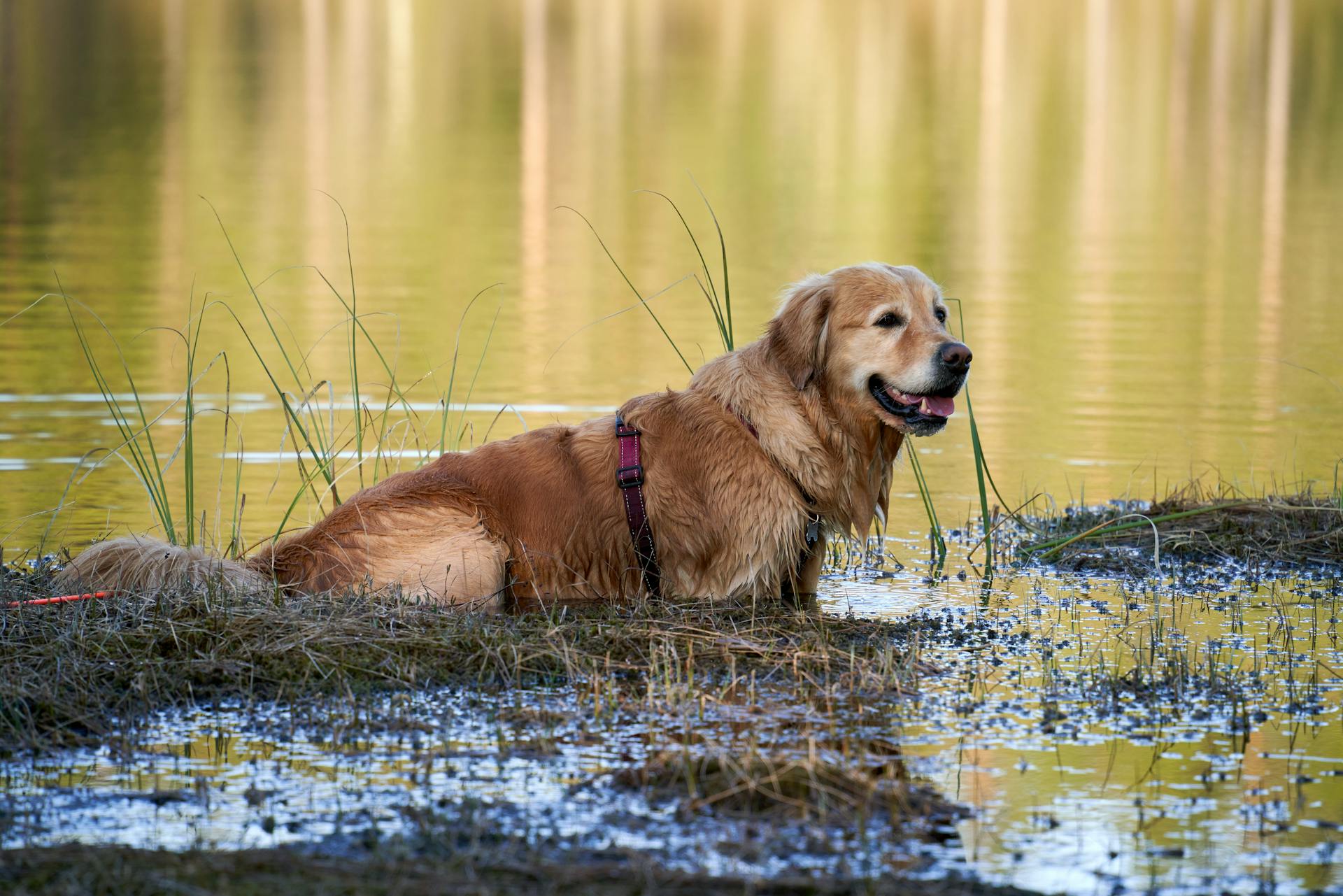
Summer is finally here, and with it comes the joy of spending time outdoors with your furry friend. However, it's essential to take precautions to ensure your dog's safety in the heat.
Dogs can quickly overheat due to their thick coats and inability to sweat like humans do. In fact, their body temperature can rise by 1-2 degrees every 5 minutes.
When the temperature rises above 80°F, the risk of heatstroke increases dramatically. This is especially true for breeds with short noses, like Pugs and Bulldogs, who are more prone to heat-related illnesses.
To keep your dog cool, provide plenty of fresh water and shade, especially during the hottest part of the day.
Dog Heat Safety Precautions
If your dog is panting heavily, it's a sign that they're trying to cool down, but they may be getting too hot. Heavy panting can be a sign of heatstroke.
Make sure your dog has access to plenty of cool water at all times. Just giving them a bowl of water may not be enough, as they also need their electrolytes replaced. You can use electrolyte-enhanced water or an electrolyte solution, and check with your veterinarian for dosage recommendations.
For more insights, see: Dogs Drinking Ocean Water
If your dog is showing signs of dehydration, such as dry gums and nose, thick saliva, lethargy, sunken eyes, or loss of elasticity in the skin, they need rehydration and replacement of electrolytes right away.
Here are some signs of heatstroke to watch out for:
- Heavy panting
- Rapid breathing
- Excessive drooling
- Bright red gums and tongue
- Difficulty maintaining balance
If your dog is showing these signs, try to cool them down immediately by getting them into the shade, using cooling mats, spraying them with cool or tepid water, and fanning them.
Pet Safety on Hot Days
On hot days, it's essential to prioritize your dog's safety. If you're uncomfortable outside, it's likely too hot for your dog to be outside for an extended period, especially during hot weather.
Certain dogs, such as older, overweight, or brachycephalic dogs, are more affected by heat and should avoid being outside in high temperatures. These dogs need extra care and attention on hot days.
To keep your dog cool, ensure they have access to plenty of shade and fresh water. Refill their water frequently, as it can get hot quickly on a steamy summer day.
Discover more: Heated Water Bowls for Dogs
Never leave your dog in the car, not even for a short period. Temperatures can rise extremely fast, even with windows open, and can reach 104 degrees in just 30 minutes on a mild day.
Here are some signs of dehydration to look out for: panting, dry gums and nose, thick saliva, lethargy, sunken eyes, and loss of elasticity in the skin. If you notice any of these symptoms, give your dog electrolyte-enhanced water or an electrolyte solution, and consult with your veterinarian for dosage recommendations.
Heat stroke is a serious medical condition that can lead to organ failure. Watch for signs of heat stroke, such as heavy panting and difficulty breathing, excessively drooling, lethargy, drowsiness, or uncoordinated movements, collapsed or vomiting. If you suspect heat stroke, get your dog inside right away and offer cool water. If possible, drape cool towels over their body or run a cool bath.
Expand your knowledge: Dog Water Safety
Breed-Specific Considerations
If you have a short-nosed dog, it's crucial to take extra precautions during hot weather. Brachiocephalic breeds, such as Bulldogs, Pekingese, and Pugs, are at an increased risk for breathing issues.
Be especially careful with these dogs, as they can't pant as efficiently due to their unique facial structure. This means they can't cool down as efficiently either, putting them at higher risk for heat stroke and other heat-related complications.
Dogs with flat faces, like those mentioned above, are more prone to heat-related health issues. Their anatomy makes it harder for them to breathe and regulate their body temperature.
Keep a close eye on your short-nosed dog's behavior and watch for signs of heat stress, such as excessive panting, drooling, or lethargy.
Pet Safety During Travel
As you prepare for a fun-filled vacation with your furry friend, it's essential to prioritize pet safety during travel. Keep your dog cool in the car by putting ice packs wrapped in a towel in their crate, and make sure the crate is well-ventilated.
You should also use a cooling pad as a bed or crate liner to provide extra comfort. Don't forget to bring along fresh water and a bowl, and a tarp or tent, so you can set up a shady spot when you stop.
If you're traveling in an RV, never leave the vehicle completely closed up, even if the generator and air-conditioning are running. Crack a window or door or run the exhaust fan to ensure proper ventilation.
When driving, your dog should be attached to a dog-safe seat belt or ride in a secured crate to prevent injury in case of sudden stops.
Sources
- https://www.rspca.org.uk/adviceandwelfare/seasonal/summer/dogs
- https://spca.bc.ca/news/dogs-sensitive-hot-weather/
- https://www.pawlicy.com/blog/how-hot-is-too-hot-for-dogs/
- https://www.akc.org/expert-advice/health/summer-safety-tips-for-dogs/
- https://www.animalhumanesociety.org/resource/five-tips-keep-your-dog-safe-summer-heat
Featured Images: pexels.com


